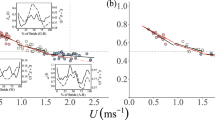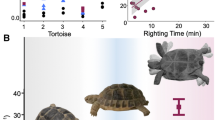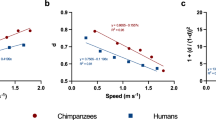Abstract
THE energy cost of pedestrian locomotion in terrestrial vertebrates has been extensively studied1–3. Insects differ fundamentally from vertebrates, making data on their locomotion energetics of great comparative interest, but their small size and low behavioural plasticity complicate measurements. Miniature treadmills4–9 enforce unnatural running regimes; therefore no data exist on the energetics of insects running voluntarily, or on insect ventilation while running. We have now measured the minimum cost of transport and ventilation of the harvester ant Pogonomyrmex rugosus (mass, 17 mg) by using both treadmill and voluntary running. The minimum cost of transport was constant over temperature (34–43 °C) and lower than predicted from vertebrate data. Treadmill running significantly affected energetics, eliminating the slow ventilation (1–2 mm–1) in voluntarily running ants and substantially elevating extrapolated metabolic rate at zero running speed, which equalled the standard metabolic rate in voluntarily running ants.
This is a preview of subscription content, access via your institution
Access options
Subscribe to this journal
Receive 51 print issues and online access
$199.00 per year
only $3.90 per issue
Buy this article
- Purchase on Springer Link
- Instant access to full article PDF
Prices may be subject to local taxes which are calculated during checkout
Similar content being viewed by others
References
Schmidt-Nielsen, K. Science 177, 222–228 (1972).
Fedak, M. A. & Seeherman, H. J. Nature 282, 713–716 (1979).
Taylor, C. R., Heglund, N. C. & Maloiy, G. M. O. J. exp. Biol. 97, 1–21 (1982).
Herreid, C. F. II, Prawel, D. A. & Full, R. J. Science 212, 331–333 (1981).
Herreid, C. F. II, Full, R. J. & Prawel, D. A. J. exp. Biol. 94, 189–202 (1982).
Herreid, C. F. II & Full, R. J. J. Insect Physiol. 30, 395–403 (1984).
Lighton, J. R. B. Physiol. Zool. 58, 390–399 (1985).
Lighton, J. R. B., Bartholomew, G. A. & Feener, D. H. Physiol. Zool. 60, 524–537 (1987).
Bartholomew, G. A., Lighton, J. R. B. & Feener, D. H. Physiol. Zool. 61, 57–68 (1988).
Punt, A., Parser, W. J. & Kuchlein, J. Biol. Bull. mar. biol. Lab., Woods Hole 112, 108–117 (1957).
Lighton, J. R. B. J. exp. Biol. 134, 363–376 (1988).
Lighton, J. R. B. J. Insect Physiol. 34, 361–367 (1988).
Buck, J. Proc. 10th Int. Congr. Entomol. 2, 399–342 (1958).
Bernstein, R. A. Am. Nat. 108, 490–498 (1974).
Moberly, W. R. Comp. Biochem. Physiol. 27, 21–32 (1968).
Lighton, J. R. B. & Bartholomew, G. A. Proc. natn. Acad. Sci. U.S.A. 85, 4765–4769 (1988).
Bartholomew, G. A., Lighten, J. R. B. & Louw, G. N. J. Comp. Physiol. 155, 155–162 (1985).
Wigglesworth, V. B. The Principles of Insect Physiology, 827 (Chapman & Hall, London, 1972).
Author information
Authors and Affiliations
Rights and permissions
About this article
Cite this article
Lighton, J., Feener Jr, D. A comparison of energetics and ventilation of desert ants during voluntary and forced locomotion. Nature 342, 174–175 (1989). https://doi.org/10.1038/342174a0
Received:
Accepted:
Issue Date:
DOI: https://doi.org/10.1038/342174a0
This article is cited by
-
Limitations and requirements for measuring metabolic rates: a mini review
European Journal of Clinical Nutrition (2017)
-
Scaling of work and energy use in social insect colonies
Behavioral Ecology and Sociobiology (2016)
-
Foraging energetics of the ant, Paraponera clavata
Oecologia (1996)
-
A reason for division of labor in ant foraging
Naturwissenschaften (1995)
-
Foraging in the seed-harvester ant genus Pogonomyrmex: are energy costs important?
Behavioral Ecology and Sociobiology (1995)
Comments
By submitting a comment you agree to abide by our Terms and Community Guidelines. If you find something abusive or that does not comply with our terms or guidelines please flag it as inappropriate.



